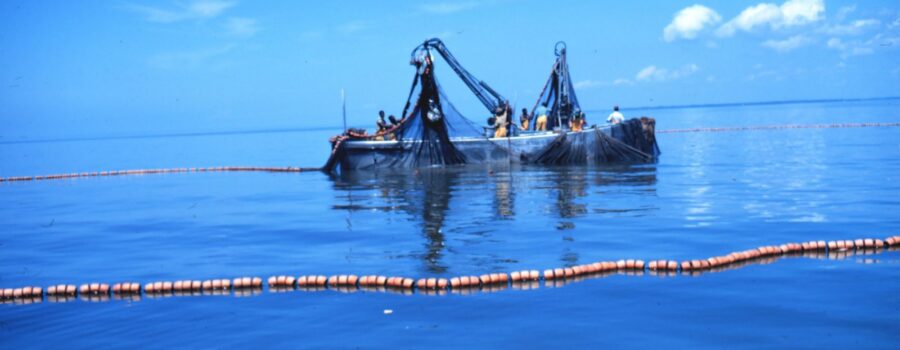Virginia’s Menhaden Reduction Fisheries Pose Massive Threat to Bay Sport Fish and Wildlife
Atlantic menhaden are small, nutrient-packed fish that are central to the Chesapeake Bay’s food chain and support one of the largest commercial fisheries on the Atlantic coast. They are a rich food source for many predator fish, including rockfish, bluefish, and weakfish, as well as ospreys, bald eagles, dolphins, and whales. As a result of their environmental and economic importance, management of the menhaden fishery is a political flashpoint across the region.
The Bay is one of the most important nurseries for menhaden, helping to sustain the population along the Atlantic coast. Menhaden eggs hatch in the open ocean before drifting on currents into the Bay, where juvenile fish live and grow for their first year of life. But long-running scientific surveys show the number of young menhaden in the Chesapeake Bay dropped dramatically in the early 1990s and remains low.
At the same time, almost three-quarters of all menhaden caught on the East Coast are harvested by a Canadian-owned reduction fishery company that fishes largely in or near the mouth of the Bay. This company operates the sole remaining menhaden reduction facility on the U.S. East Coast in Virginia. The plant reduces (cooks and grinds up) the fish for a variety of uses, such as nutritional supplements, food additives, and feed for livestock and fish farms.
Menhaden migrate along the Atlantic coast from Florida to Maine and an interstate governing body – the Atlantic States Marine Fisheries Commission (ASMFC) – manages the fishery for the 15 states that share the coastline. Over the past two decades, fishery managers have raised concerns that the concentration of fishing efforts in Bay waters could disrupt the Bay’s food chain, harming populations of various fish species. As a precaution, the ASMFC first set a cap for the reduction fishery’s industrial menhaden fish harvest in the Bay in 2006. In 2017, the ASMFC voted to update the cap to reflect more recent menhaden harvest levels in the Bay.
In blatant disregard for the fishery management process, the reduction company knowingly exceeded the cap in 2019. The violation resulted in a unanimous ASMFC vote referring Virginia to the U.S. Department of Commerce for noncompliance with interstate fishery rules. The Secretary of Commerce decided to uphold the ASMFC decision. The new harvest cap approved by the Virginia Marine Resources Commission (“VMRC”) in April 2020 lowered the amount of menhaden that can be caught in the Chesapeake Bay to 51,000 metric tons per year. However, even with the cap reduction, menhaden numbers within the Bay remain dangerously low, and the VMRC has failed to take any further action that meaningfully addresses this fisheries crisis.
A major question among scientists and legislators has been “would it aid in the rebuilding of the Chesapeake Bay striped bass spawning stock and in preventing osprey nesting failures to increase menhaden in the Bay?” Opinions from leading scientists say that it would.
One management option would be to require that factory fishing taking place in the U.S. Atlantic zone to occur outside of the Chesapeake Bay and Virginia state waters. This is what every state but Virginia has done; however, it is unclear whether ASMFC may take an action that prevents fishing in state waters (e.g. Virginia waters) as that may interfere with “state sovereignty.”
However, because the supply of migrating menhaden throughout the Bay watershed – and the condition of the fish and wildlife in those watersheds – is directly dependent on migrating menhaden populations in Virginia and because Section Six (a)(7) of the ASMFC Charter requires that “fishery resources shall be fairly and equitably allocated… among the states,” are Maryland and other northern Bay states forced to surrender their sovereignty since they cannot control what happens in Virginia waters? By moving factory fishing into the U.S. Zone, the reduction fishery company would be forced to fish from menhaden schools in Atlantic circulation, not from schools migrating near Virginia shores, just miles away from crossing into Maryland.
Another issue is that the ASMFC allocates 78% of all the menhaden caught on the Atlantic coast to Virginia (151,392 metric tons – about 15,000 schools). Of this allocation, Virginia then allocates 90% of that share to the reduction company. It may be argued that this is a waste of precious natural resources in violation of the first few sentences of the ASMFC Charter that prohibits the waste of a fishery.
Finally, there appear to be several other issues that arise concerning Virginia’s menhaden allocation to the reduction company under the Code of Virginia § 28.2-203 (1)-(4). For one, is the Virginia Marine Resources Commission in its allocation of menhaden applying the preferences for food fishermen (finfish fishermen) and recreational anglers in Section (1)? Is the Commission following conservation or science required in Section (2) when it just uses historic landings? And third, is the Virginia Marine Resources Commission applying the rule that “no person acquires an excessive share” as seen in Section (4), even though the reduction company is allotted more than twice as much menhaden as all the other states and fishermen on the Atlantic coast?
Regardless of what section of what Charter has been violated, one thing is clear – something must be done to restore the Bay’s menhaden population which is so integral to the Bay ecosystem, and locals’ livelihoods.



